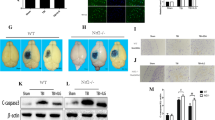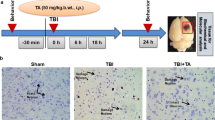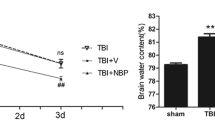Abstract
l-Cysteine is a well-known sulfur-containing non-essential amino acid that can be oxidized to cysteine, which possesses a variety of pharmacological actions, including antioxidant and anti-inflammatory activities. Traumatic brain injury (TBI) is defined as a closed head injury that leads to temporary alterations in neural function and further leads to pathophysiological processes. In the present study, rats were categorized into sham, control, 100 mg/kg l-cysteine, and 200 mg/kg l-cysteine groups and then the levels of lipid peroxidation, reduced glutathione (GSH), catalase, superoxide dismutase (SOD), reactive oxygen species (ROS), and mRNA and protein expression of microtubule-associated protein 2 (MAP2) were determined. Following supplementation with l-cysteine, there were reductions in lipid peroxidation and ROS levels, whereas catalase, SOD, and GSH levels increased. Additionally, the mRNA expression of MAP2 in the control rats was drastically reduced by 67% compared to the sham rats. However, supplementation with 100 mg/kg of l-cysteine and 200 mg/kg of l-cysteine significantly increased MAP2 mRNA expression by 84.8% and 169.7%, respectively. Similarly, MAP2 protein expression was drastically reduced by 61% in control rats compared to sham rats, but supplementation with 100 mg/kg of l-cysteine and 200 mg/kg of l-cysteine significantly increased MAP2 protein expression by 41% and 94.9%, respectively. Taken together, these data suggest that supplementation with l-cysteine significantly reduced lipid peroxidation and ROS levels, but increased antioxidant levels and the mRNA and protein expression of MAP2 in rats following TBI.





Similar content being viewed by others
References
Arnér ES, Holmgren A (2006) The thioredoxin system in cancer. Semin Cancer Biol 16(6):420–426
Balic M, Rapp N, Stanzer S, Lin H, Strutz J, Szkandera J, Daidone MG, Samonigg H, Cote RJ, Dandachi N (2011) Novel immunofluorescence protocol for multimarker assessment of putative disseminating breast cancer stem cells. Appl Immunohistochem Mol Morphol 19:33–40
Bavarsad Shahripour R, Harrigan MR, Alexandrov AV (2014) N-acetylcysteine (NAC) in neurological disorders: mechanisms of action and therapeutic opportunities. Brain Behav 4(2):108–122
Baydas G, Gursu MF, Yilmaz S, Canpolat S, Yasar A, Cikim G, Canatan H (2002) Daily rhythm of glutathione peroxidase activity, lipid peroxidation and glutathione levels in tissues of pinealectomized rats. Neurosci Lett 323:195–198
Bobyn PJ, Franklin JL, Wall CM, Thornhill JA, Juurlink BH, Paterson PG (2002) The effects of dietary sulfur amino acid deficiency on rat brain glutathione concentration and neural damage in global, hemispheric hypoxia-ischemia. Nutr Neurosci 5(6):407–416
Buddle M, Eberhardt E, Ciminello LH, Levin T, Wing R, DiPasquale K, Raley-Susman KM (2003) Microtubule-associated protein 2 (MAP2) associates with the NMDA receptor and is spatially redistributed within rat hippocampal neurons after oxygen-glucose deprivation. Brain Res 978(1–2):38–50
Carbone DL, Doorn JA, Kiebler Z, Petersen DR (2005) Cysteine modification by lipid peroxidation products inhibits protein disulfide isomerase. Chem Res Toxicol 18(8):1324–1331
d’Hemecourt P (2011) Subacute symptoms of a sports-related concussion: outpatient management and return to play. Clin Sports Med 30:63–72
Dilger RN, Toue S, Kimura T, Sakai R, Baker DH (2007) Excess dietary l-cysteine, but not l-cystine, is lethal for chicks but not for rats or pigs. J Nutr 137(2):331–338
Eakin K, Baratz-Goldstein R, Pick CG, Zindel O, Balaban CD, Hoffer ME, Lockwood M, Miller J, Hoffer BJ (2014) Efficacy of N-acetyl cysteine in traumatic brain injury. PLoS One 9(4):e90617
Elias RJ, McClements DJ, Decker EA (2005) Antioxidant activity of cysteine, tryptophan, and methionine residues in continuous phase beta-lactoglobulin in oil-in-water emulsions. J Agric Food Chem 53(26):10248–10253
Fechter LD, Nelson-Miller A, Gearhart C (2008) Depletion of liver glutathione levels in rats: a potential confound of nose-only inhalation. Inhal Toxicol 20(9):885–890
Fontaine-Lenoir V, Chambraud B, Fellous A, David S, Duchossoy Y, Baulieu EE, Robel P (2006) Microtubule-associated protein 2 (MAP2) is a neurosteroid receptor. Proc Natl Acad Sci USA 103(12):4711–4716
Hasegawa S, Ichiyama T, Sonaka I, Ohsaki A, Okada S, Wakiguchi H, Kudo K, Kittaka S, Hara M, Furukawa S (2012) Cysteine, histidine and glycine exhibit anti-inflammatory effects in human coronary arterial endothelial cells. Clin Exp Immunol 167(2):269–274
Higashikata T, Yamagishi M, Sasaki H, Minatoya K, Ogino H, Ishibashi-Ueda H, Hao H, Nagaya N, Tomoike H, Sakamoto A (2004) Application of real-time RT-PCR to quantifying gene expression of matrix metalloproteinases and tissue inhibitors of metalloproteinases in human abdominal aortic aneurysm. Atherosclerosis 177:353–360
Hoffer BJ, Pick CG, Hoffer ME, Becker RE, Chiang YH, Greig NH (2017) Repositioning drugs for traumatic brain injury-N-acetyl cysteine and Phenserine. J Biomed Sci 9 24(1):71
Jain SK, Kanikarla-Marie P, Warden C, Micinski D (2016) l-cysteine supplementation upregulates glutathione (GSH) and vitamin D binding protein (VDBP) in hepatocytes cultured in high glucose and in vivo in the liver, and increases blood levels of GSH, VDBP, and 25-hydroxy-vitamin D in Zucker diabetic fatty rats. Mol Nutr Food Res 60(5):1090–1098
Jordão AA, Chiarello PG, Arantes MR, Meirelles MS, Vannucchi H (2004) Effect of an acute dose of ethanol on lipid peroxidation in rats: the action of vitamin E. Food Chem Toxicol 42:459–464
Karanth J, Jeevaratnam K (2005) Oxidative stress and antioxidant status in rat blood, liver and muscle: effect of dietary lipid, carnitine, and exercise. Int J Vitam Nutr Res 75(5):333–339
Kim HJ, Han SJ (2017) A simple rat model of mild traumatic brain injury: a device for reproducing anatomical and neurological changes of mild traumatic brain injury. PeerJ 5:e2818
Landino LM, Skreslet TE, Alston JA (2004) Cysteine oxidation of tau and microtubule-associated protein-2 by peroxynitrite: modulation of microtubule assembly kinetics by the thioredoxin reductase system. J Biol Chem 279(33):35101–35105
Lee S, Han KH, Nakamura Y, Kawakami S, Shimada K, Hayakawa T, Onoue H, Fukushima M (2013) Dietary l-cysteine improves the antioxidative potential and lipid metabolism in rats fed a normal diet. Biosci Biotechnol Biochem 77(7):1430–1434
Li J, Xu L, Deng X, Jiang C, Pan C, Chen L, Han Y, Dai W, Hu L, Zhang G, Cheng Z, Liu W (2016) N-acetyl-cysteine attenuates neuropathic pain by suppressing matrix metalloproteinases. Pain 157(8):1711–1723
Miura Y, Honda S, Masuda A, Masuda T (2014) Antioxidant activities of cysteine derivatives against lipid oxidation in anhydrous media. Biosci Biotechnol Biochem 78(8):1452–1455
Miyazawa T, Bonnekoh P, Hossman KA (1993) Temperature effect on immunostaining of microtubule-associated protein 2 and synaptophysin after 30 minutes of forebrain ischemia in rat, Acta. Neuropathol 85:526–532
Roesslein M, Hirsch C, Kaiser JP, Krug HF, Wick P (2013) Comparability of in vitro tests for bioactive nanoparticles: a common assay to detect reactive oxygen species as an example. Int J Mol Sci 14(12):24320–24337
Ruff RM (2011) Mild traumatic brain injury and neural recovery: rethinking the debate. NeuroRehabilitation 28:167–180
Saleh AAS (2015) Anti-neuroinflammatory and antioxidant effects of N-acetyl cysteine in long-term consumption of artificial sweetener aspartame in the rat cerebral cortex. J Basic Appl Zool 72:73–80
Saravanan N, Senthil D, Varalakshmi P (1995) Effect of L-cysteine on lipid peroxidation in experimental urolithiatic rats. Pharmacol Res 32(3):165–169
Xiong Y, Mahmood A, Chopp M (2013) Animal models of traumatic brain injury. Nat Rev Neurosci 14(2):128–142
Ye S, Dong J, Han B (2010) Protective effect of reduced glutathione and venous systemic oxygen persufflation on rat steatotic graft following liver transplantation. J Surg Res 158:138–146
Acknowledgement
This study was supported by National Natural Sciences Foundation of China (Grant No.81801721).
Author information
Authors and Affiliations
Corresponding author
Ethics declarations
Conflict of interest
Authors declare that they have no conflict of interest.
Rights and permissions
About this article
Cite this article
Ouyang, Z., Xu, G. & Jiang, Y. l-Cysteine augments microtubule-associated protein 2 levels and enhances antioxidant activity in rats following traumatic brain injury. 3 Biotech 9, 280 (2019). https://doi.org/10.1007/s13205-019-1805-6
Received:
Accepted:
Published:
DOI: https://doi.org/10.1007/s13205-019-1805-6




